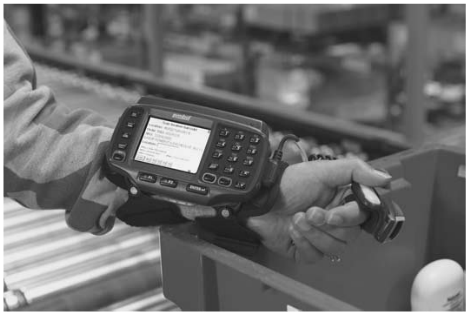A barcode consists of a series of vertical bars of varying widths that represent letters, numbers and other symbols. Barcodes are used to identify products, locations in the warehouse, containers (totes, cartons, pallets), serial and batch numbers. As with many areas of logistics, there is no conformity and thus no universal barcode. This can make it difficult to transfer products between companies and countries. The main barcode standards include EAN-8, EAN-13 and Code 128. Recent developments include two-dimensional barcodes, the advantage being that you can store a greater amount of data within a much smaller space. Figure below shows One-dimensional and two-dimensional barcodes.

Barcode readers can be hand held, static or wearable. The hand-held scanner has a screen and a trigger. It scans the barcode, deciphers it and stores or transmits it to a computer. These scanners have the ability to read a number of different types of barcode, which will depend on the manufacturer, model and cost.
Data can be read, stored in the scanner and then downloaded by attaching the scanner to the computer via a USB connection. Information can also be transferred in real time via RF. A pen or wand scanner swipes the barcode through contact and reads and deciphers the information.
Some disadvantages are – the manager needs to be trained how to read bar codes etc. Hand held devices can lead to errors if they are holstered or put down on a surface, dropped or mishandled. This can lead to picking from wrong locations or miscount of items.
A development over the stationary scanner is use of hands-free, wearable computers that enable the operator to handle product with both hands as opposed to having to hold a barcode scanner, paper pick list or roll of labels. A wireless-enabled, wearable computer allows operators to receive instructions in real time, scan barcodes, enter data and transmit in real time. Wearable computers are typically worn on the wrist or lower arm and feature a screen and a small keyboard or touch screen, with the option of a finger-mounted scanner that either plugs into the unit or communicates via Bluetooth technology

Figure: Wearable RDT with finger scanner
By using wearable computers, one task is eliminated, thus making the pick process quicker and potentially reducing errors. Productivity and accuracy improvements can quickly add up to substantial savings.
The computers can also be supplied with easy-to-read touch screen and two-dimensional imagers. They can be configured to be voice enabled, allowing pick operations to be even more accurate as items can be scanned to ensure the correct item has been picked from the location.
There are a number of ‘symbologies’ established by different organizations for varying purposes (eg for retail sales, outer packaging or for use in specific industries). The codes are normally structured, so that, for example, the first few bars indicate the ‘symbology’, then the next few bars may indicate the national coding authority, the manufacturer, then the product number, and, oft en, finally, a check digit. The bar codes are read by scanners for direct input into the computer system.
Optical character recognition (OCR)
OCR labels can be read by both humans and text scanners. However, this technology tends to be less reliable than bar coding and data formats are limited. OCR technology is more common in document handling.

